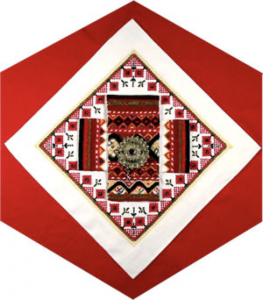Macedonia

The Block
An antique, silver toka, commonly worn in the middle of a waistband from which money is hung at a wedding, is at the centre of the Macedonia block. The cloth used in the block was collected and donated by Lou Sekulovski. The multi-layered clothing, worn by Macedonians, is reflected in the layered embroideries, executed by Milka Sekulovski and Dragica Bogdanovic, that fill the square. Each region of the country has its own varied embroidery patterns and colours, and the textile upon which the toka is cushioned is a wonderful example of the many complex needlework motifs found here. Cross stitch was used to create an intricate geometric design surrounding the inner section, while a thin band of flax borders the entire piece. Flax is grown for its oil and fibre and is also woven into linen that is an important fabric used in national costumes.
Cultural Profile
Macedonia, located in southeastern Europe, is a country of deep valleys and rugged mountains. It has one of the most complex ethnic populations on the continent and includies Macedonian Slavs, Albanians, Turks, Roma (gypsies) and Serbs. Macedonian, a language mutually intelligible with Bulgarian, is spoken by the majority of the population. The territory of present-day Macedonia has been inhabited for 9,000 years, thus it has Bronze Age stone structures, Roman ruins, Byzantine bazaars as well as modern architecture in the country. Religion, especially the Macedonian Orthodox Church, has left an important imprint in the country’s cultural heritage. The city of Ohrid was said to house 365 churches in the 17th century, one for every day of the year, though their number has gone down in modern times. Numerous wood carvings and frescoes are found in the countries churches and monasteries. Folk traditions of Macedonia include the oro, traditional folk dances related to the Balkans’ hora. These circle dances are performed by either men or women, though some dances are gender specific. They are an integral part of celebrations such as weddings, christenings, name-days or national and religious holidays. The country takes pride in its wide array of folk costumes. There are up to 70 variations of the dress, each identifying a specific region of the country. All feature rich embroidered patterns as well as ornate jewellery. These costumes are worn during weddings, traditional folk dances or national days. Wool, cotton and silk weaving are all practiced in the country. Wool rugs such as the kilimi, featuring brightly coloured geometric patterns, are made in many homes. Beautiful hand-made lace is an art form that endures. Embroidery is used not only on folk costumes, but also adorns household items. Leatherwork, such as the opanci shoes, and pottery are also very popular handcrafted items. Previously listed under ‘Yugoslavia’ in immigration records, Macedonians were one of the largest groups of non-British settlers to arrive in Canada in the late 1890s. Settling mainly in Ontario, they came as unskilled labourers, looking for a better quality of life. At first they lived an isolated existence centered around their church and boarding houses, but in time they became entrepreneurs, opening their own restaurants and businesses. A 2011 census indicates 36,000 Macedonians now live in Canada, however community spokespersons believe there are actually 100,000 to 150,000 just in the Greater Toronto Area, creating the largest Macedonian settlement outside the Balkans. The Macedonians’ great determination to retain their language and culture is apparent in the many churches, organizations and businesses located within their communities.
Sponsor: United Macedonian Organizations of Canada
